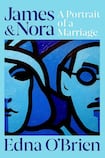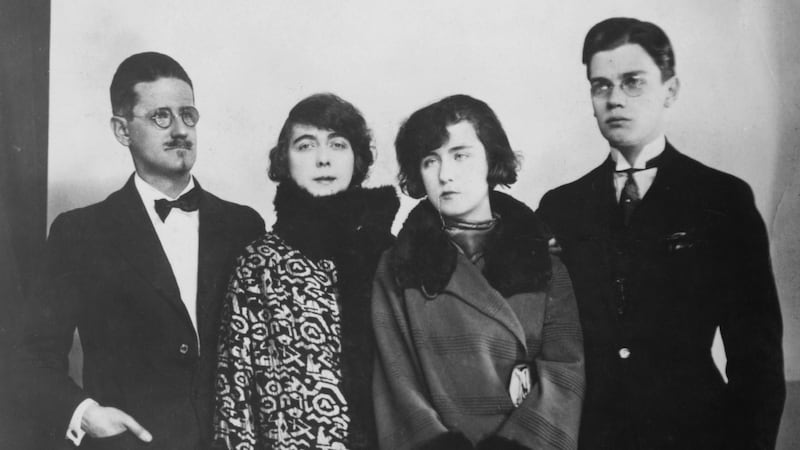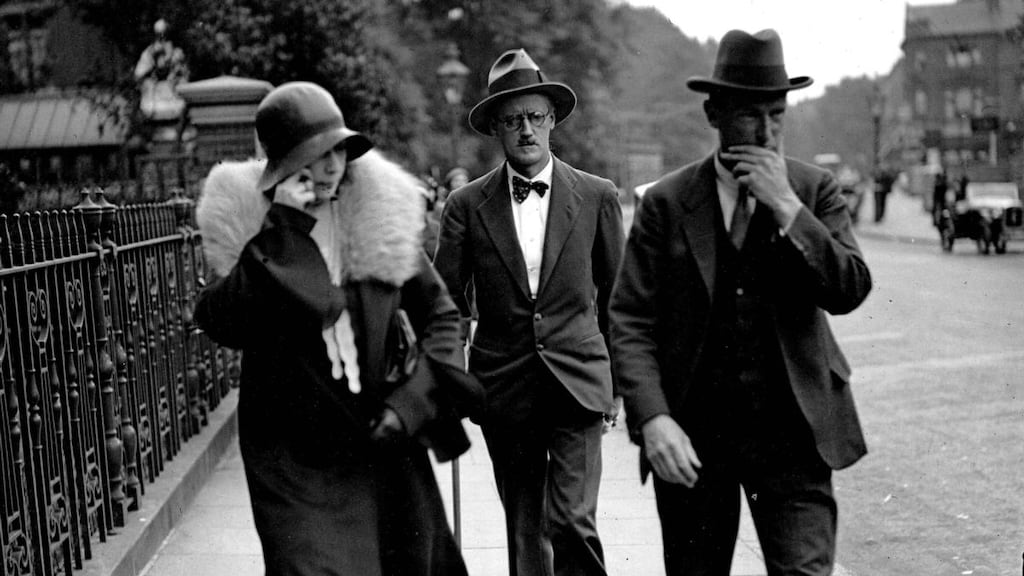
Artists, from Shakespeare to Virginia Woolf, frequently favour an adrogynous style. Edna O’Brien’s portrait of the relationship of James Joyce and Nora Barnacle develops in a similar mode, dispensing with question-marks and full-stops as Barnacle often did, while employing the learned words and complex phrases which gave pleasure to Joyce. She incorporates lines from Ulysses and Finnegans Wake into her luminous text, based on a strong instinct that such phrases were intrinsic to the couple’s exchanges: “first we feel, then we fall”.
While many marriages of modernists ended in acrimony or indifference, this one was different. These two were married at the deepest levels of imagination. Neither saw bourgeois marriage as a form of property-holding: “with this ring I thee own”. When Leopold Bloom, fictional hero of Ulysses and bearer of many Joycean traits, sighs about his wife’s infidelity, “Can’t stop woman, As easy stop the sea”, Molly hours later (and quite separately) forgives herself her fling with Blazes Boylan by comparing the waves of sexual attraction to the ebb and flow of the sea-tides.
The couple’s legal wedding was deferred for 27 years (counting from 1904). This was a perfect arrangement for these free spirits, since it permitted a regular testing and strengthening of vows and precluded a lapse into the routines that could dull some marriages.


The legal wedding occurred in 1931 in the same Kensington Registry Office at which years earlier DH Lawrence had married Frieda von Richthofen. Unlike Lawrence and Richthofen, by then icons of sexual freedom, the Irish couple had allowed many happy years of foreplay to elapse before this state solemnisation (done for practical reasons of their children’s inheritance etc).
What fun there might have been had the two great authors arrived at Kensington on the same day! Lawrence told his wife that the Molly Bloom monologue was “the dirtiest, most indecent, most obscene thing ever written”. Joyce riposted that Lady Chatterbox’s Lover (as he would insist on calling it) was lush and sloppy –“its ending a piece of propaganda for something which outside of DHL’s country at any rate makes all the propaganda for itself”.
Joyce’s work celebrates the individual man and woman whom we might meet in the streets. However, the entire tendency of Ulysses and the Wake, as O’Brien sensitively shows, is to move well beyond traditional ideas of the individual towards an androgynous being in whom there is no impediment to the marriage of true minds, male and female. Joyce, in O’Brien’s reading, is far more motherly than Nora, who seems to have had a competitive-sisterly relation to daughter Lucia. Nora herself, even in her young womanhood in Galway, liked to dress in men’s clothes, if only to see what offers came her way on the Galway quays.
James and Nora learned a lot. As prisoners of sex, they transcended it altogether, beyond love and lust, beauty and bestiality
O’Brien has already written one of the very best books on Joyce and women, titled simply James Joyce (1999). Her celebration of Nora over the intervening years remains steadfast, but she has somewhat revised her view of Joyce’s mother, May Murray. Always aware of the danger of smother-love, Irish-style, the James of the earlier book maintained a hygienic social distancing, “not allowing his mother to embrace him because he feared contact with women”.
Yet O’Brien in that volume very movingly interpreted her letters to him in Paris as pleas of a lonely woman for “some sort of spiritual companionship”, of the sort May did not long enjoy with her husband, who said that “the name Murray stank in his nostrils”. John Joyce may have been simply jealous of their rapport. Interestingly, James’s own kids would, in O’Brien’s view, be deeply envious of the intensity of feeling between their parents.

There was something platonically romantic in May Joyce’s letters to her brilliant elder son. Younger brother Stanislaus (perhaps feeling left out of all this) tersely commented: “if James longed to copulate with a soul, he ought to have got himself born anywhere other than in Ireland”. O’Brien argued in 1999 that it is only with our bodies that we forgive one another: the mind harbours all the old hurts. Stanislaus said that women interest Irishmen only as housekeepers and streetwalkers; and his brother fled both varieties.
In this latest book, O’Brien is less intrigued by the intellectual companionship offered by May and represents her rather as an agent of Catholic repression, haunting James’ guilty dreams. John Joyce, feckless father, stands on the other hand for joy (Joyce), full of jocular pride in the son’s intellect. Yet that son had the good sense to flee the fatherly economic hopes in a gifted graduate who might be called upon to restore the family fortune wasted by the old boy’s drinking.
The fate of May Joyce, exhausted in her coffin at 44 by all this carry-on, was another warning that no free life could be lived by her eldest surviving child in Dublin. The father, on learning that the son had fled with a chambermaid, called him a blackguard; but found a strangely ambiguous kind of hope in her name, Barnacle (“she will stick to him forever”). As she did, often calling him in moments of orgasmic passion “Mr Joyce” rather than “Jimmy”. “Mr Joyce” is a designation employed with intermittent suddenness by O’Brien, here and in other writings, as if she herself at moments of immense respect may also be feeling the hots for him!
Her lovely, lyrical book illustrates just how androgynous many unusual but lasting marriages can be. Her Joyce, like Bloom, harbours a wish to be a mother (in Ulysses, Bloom plays the role of the dead May Dedalus in rescuing her son from the whores of Nighttown). Molly wishes for a penis and to bestride her own thighs – Nora likewise. Ulysses shows how many good men are womanly and many good women manly; and often attracted to one another – a thesis already advanced by Sigmund Freud.
The Joyce-Barnacle coupling was an experiment. They wished to know one another beyond those cliches of masculinity and femininity, which threatened to take the very act away from those who performed it. The bridal bed had too often become an epicentre of poseurs, for as one poet would observe “we learn nothing here we did not know”.
But James and Nora learned a lot. As prisoners of sex, they transcended it altogether, beyond love and lust, beauty and bestiality. In the words of John Donne, who centuries earlier had intuited some of these breakthroughs, “we two, being one, are it”. So, at the end of Ulysses, it is deeply unclear whether the word “yes” belongs to Leopold or Molly. Truly, like the book, it belongs to both.
James and Nora – or should that be Nora and James (as in Eve and Adam at the start of the Wake)? – is short, poetic and powerful. O’Brien has found an image of her own dignified audacity in Nora, who insisted on sex her way. The pornographic tradition over previous centuries of literature and painting, being based only on male fantasy rather than female desire, was no better (in the words of Angela Carter) than “a manual of navigation written by land-lubbers for land-lubbers”.
All of O’Brien’s writings, like Joyce’s, have said goodbye to all that, ushering in a kinder, wilder, more loving world. For all her candour about sex, O’Brien writes with a moving discretion about how the love of humans is the nearest we can approach to the heights and despairs of the mystic’s religious ecstasy.
Declan Kiberd is the author of Ulysses and Us (Faber & Faber). He teaches at the University of Notre Dame.










